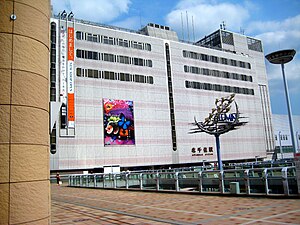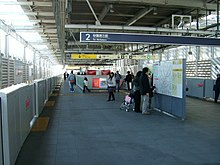Kita-Senju Station
JJ05 TS09 H21 C18 Kita-Senju Station 北千住駅 | |
|---|---|
 West Exit | |
| General information | |
| Location | Adachi, Tokyo Japan |
| Operated by | |
| Line(s) | |
| Other information | |
| Station code | H-21, C-18, 05, TS-09 |
| History | |
| Opened | 1896 |
| Passengers | |
| JR East, FY2013 | 203,428 daily |
| Location | |
Kita-Senju Station (北千住駅, Kitasenju-eki) is a railway station in Adachi, Tokyo, Japan. Kita-Senju is the third-busiest station on the Tokyo Metro network (Ikebukuro being the busiest station). It is the tenth-busiest JR East station.[1]
Lines
Kita-Senju Station is served by the following lines.
- JR East Jōban Line
- Tobu Skytree Line
- Tokyo Metro Chiyoda Line
- Tokyo Metro Hibiya Line
- Tsukuba Express
Station layout




JR East
| 1-2 | JJ Jōban Line (Rapid) | for Matsudo, Toride, and Tsuchiura ■ Narita Line for Narita |
| 2-3 | JJ Jōban Line (Rapid) | for Nippori, Ueno, Tokyo, and Shinagawa |
Tokyo Metro Chiyoda Line
| 1 | C Tokyo Metro Chiyoda Line | for Nishi-nippori, Otemachi, and Yoyogi-uehara |
| 2 | C Tokyo Metro Chiyoda Line | for Ayase JL Jōban Line (Local) for Abiko and Toride |
Tobu Skytree Line and Tokyo Metro Hibiya Line
Platforms 1 to 4 are located on the first floor, and platforms 5 to 7 are located on the third floor.
| 1, 2 | ■ Tobu Skytree Line | Limited Express services for Tōbu Nikkō, Kinugawa-Onsen, Akagi, Kuzū, Ashikagashi, Ōmiya, Ōta, Isesaki, and Tōbu Utsunomiya Other services for Takenotsuka, Shin-Koshigaya, Tōbu-Dōbutsu-Kōen, Kuki, Tatebayashi, Ashikagashi, Ōta, Minami-Kurihashi, Shin-Tochigi, Tōbu Nikkō, and Aizu Tajima |
| 3, 4 | ■ Tobu Skytree Line | for Oshiage and Asakusa Tokyu Den-en-toshi Line for Chūō-Rinkan |
| 5 | ■ Tobu Skytree Line (Through trains from Tokyo Metro Hibiya Line) | for Takenotsuka, Kita-Koshigaya, Kita-Kasukabe, Tōbu-Dōbutsu-Kōen, and Minami-Kurihashi |
| 6, 7 | ○ Tokyo Metro Hibiya Line | for Ueno, Ginza, Roppongi, and Naka-Meguro |
Metropolitan Intercity Railway Company
| 1 | ■ Tsukuba Express | for Minami-Nagareyama, Moriya, and Tsukuba |
| 2 | ■ Tsukuba Express | for Akihabara |
Adjacent stations
| « | Service | » | ||
|---|---|---|---|---|
| Jōban Line (Rapid) JJ05 | ||||
| Nippori NPRJJ02
|
Special Rapid | Matsudo JJ06 | ||
| Minami-Senju JJ04 | Rapid[Note 1] | Matsudo JJ06 | ||
| Tokyo Metro Chiyoda Line C18 | ||||
| Otemachi C11 | Limited Express Romancecar | Terminus | ||
| Machiya C17 | Express | Ayase C19 | ||
| Machiya C17 | Tama Express | Ayase C19 | ||
| Machiya C17 | Semi Express | Ayase C19 | ||
| Machiya C17 | Local | Ayase C19 | ||
| Tokyo Metro Hibiya Line H21 | ||||
| Minami-senju H20 | - | Kosuge TS10 (Tobu Skytree Line) | ||
| Tobu Skytree Line (TS-09) | ||||
| Tokyo Skytree (TS-02) | Limited Express Spacia | Kasukabe (TS-27) | ||
| Tokyo Skytree (TS-02) | Limited Express Ryōmō | Tōbu-Dōbutsu-Kōen (TS-30) | ||
| Tokyo Skytree (TS-02) | Limited Express Shimotsuke | Kasukabe (TS-27) | ||
| Tokyo Skytree (TS-02) | Limited Express Revaty | Kasukabe (TS-27) | ||
| Tokyo Skytree (TS-02) | Limited Express Skytree Liner | Sengendai (TS-24) | ||
| Tokyo Skytree (TS-02) | Limited Express Urban Park Liner | Sengendai (TS-24) | ||
| Hikifune (TS-04) | Express | Nishiarai (TS-13) | ||
| Ushida (TS-08) | Section Express | Nishiarai (TS-13) | ||
| Hikifune (TS-04) | Semi Express | Nishiarai (TS-13) | ||
| Ushida (TS-08) | Section Semi Express | Nishiarai (TS-13) | ||
| Ushida (TS-08) | Local | Kosuge (TS-10) | ||
| Minami-Senju (H-20) | Local (Tokyo Metro Hibiya Line) | Kosuge (TS-10) | ||
| Tsukuba Express (05) | ||||
| Minami-Senju (04) | Rapid | Minami-Nagareyama (10) | ||
| Minami-Senju (04) | Commuter-Rapid | Rokuchō (07) | ||
| Minami-Senju (04) | Semi-Rapid | Yashio (08) | ||
| Minami-Senju (04) | Local | Aoi (06) | ||
- ^ including medium distance local trains
History

The station opened on 25 December 1896.[2]
From 17 March 2012, station numbering was introduced on all Tobu lines, with Kita-Senju Station becoming "TS-09".[3]
Passenger statistics
In fiscal 2013, the JR East station was used by an average of 203,428 passengers daily (boarding passengers only), making it the tenth-busiest station operated by JR East.[1] In fiscal 2013, the Tokyo Metro Chiyoda station was used by an average of 283,962 passengers per day and the Tokyo Metro Hibiya station was used by an average of 291,466 passengers per day. Note that the latter statistics consider passengers who travel through Kita-Senju station on a through service as users of the station, even if they did not disembark at the station. The Chiyoda Line station is the third-busiest on the Tokyo Metro network which does not offer through services onto other lines.[4] The JR East passenger figures for previous years are as shown below.
| Fiscal year | Daily average |
|---|---|
| 2000 | 183,611[5] |
| 2005 | 177,104[6] |
| 2010 | 195,260[7] |
| 2011 | 194,136[8] |
| 2012 | 198,624[9] |
| 2013 | 203,428[1] |
See also
References
- ^ a b c 各駅の乗車人員 (2013年度) (in Japanese). Japan: East Japan Railway Company. Archived from the original on 6 May 2001. Retrieved 31 August 2014.
{{cite web}}: Unknown parameter|deadurl=ignored (|url-status=suggested) (help); Unknown parameter|trans_title=ignored (|trans-title=suggested) (help) - ^ 日本国有鉄道停車場一覧. Japan: Japanese National Railways. 1985. p. 103. ISBN 4-533-00503-9.
{{cite book}}: Unknown parameter|trans_title=ignored (|trans-title=suggested) (help) - ^ 「東武スカイツリーライン」誕生! あわせて駅ナンバリングを導入し、よりわかりやすくご案内します (pdf). Tobu News (in Japanese). Tobu Railway. 9 February 2012. Retrieved 27 May 2012.
{{cite web}}: Unknown parameter|trans_title=ignored (|trans-title=suggested) (help) - ^ 各駅の乗降人員ランキング (in Japanese). Tokyo Metro. Retrieved 31 August 2014.
{{cite web}}: Unknown parameter|trans_title=ignored (|trans-title=suggested) (help) - ^ 各駅の乗車人員 (2000年度) (in Japanese). Japan: East Japan Railway Company. Archived from the original on 9 October 2014. Retrieved 1 August 2013.
{{cite web}}: Unknown parameter|deadurl=ignored (|url-status=suggested) (help); Unknown parameter|trans_title=ignored (|trans-title=suggested) (help) - ^ 各駅の乗車人員 (2005年度) (in Japanese). Japan: East Japan Railway Company. Archived from the original on 9 October 2014. Retrieved 1 August 2013.
{{cite web}}: Unknown parameter|deadurl=ignored (|url-status=suggested) (help); Unknown parameter|trans_title=ignored (|trans-title=suggested) (help) - ^ 各駅の乗車人員 (2010年度) (in Japanese). Japan: East Japan Railway Company. Archived from the original on 6 October 2014. Retrieved 1 August 2013.
{{cite web}}: Unknown parameter|deadurl=ignored (|url-status=suggested) (help); Unknown parameter|trans_title=ignored (|trans-title=suggested) (help) - ^ 各駅の乗車人員 (2011年度) (in Japanese). Japan: East Japan Railway Company. Archived from the original on 8 October 2014. Retrieved 1 August 2013.
{{cite web}}: Unknown parameter|deadurl=ignored (|url-status=suggested) (help); Unknown parameter|trans_title=ignored (|trans-title=suggested) (help) - ^ 各駅の乗車人員 (2012年度) (in Japanese). Japan: East Japan Railway Company. Archived from the original on 7 October 2014. Retrieved 31 August 2014.
{{cite web}}: Unknown parameter|deadurl=ignored (|url-status=suggested) (help); Unknown parameter|trans_title=ignored (|trans-title=suggested) (help)


